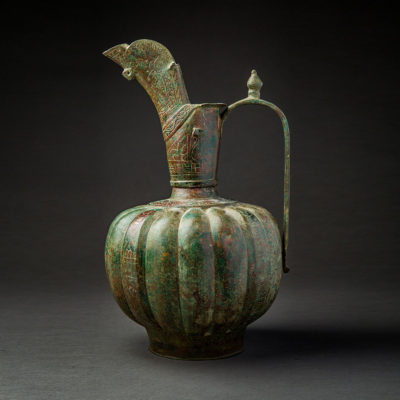
| SKU | LO.1030 |
|---|---|
| Circa | 12th Century AD to 13th Century AD |
| Dimensions | 12.25″ (31.1cm) high |
| Medium | Bronze |
| Origin | Central Asia |
| Gallery Location | UK |
Copper alloy ewer with globular fluted body with incised and repousse' decoration, the curved strap handle with a small knob finial. The whole surface with incised motifs and kufic inscriptions and low-relief bands and medallions on the body. The animated well spaced and perfectly suited decoration is in tune with the artistic production of the mid 12th century, when a huge variety of decorative themes and typologies were spurred, commissioned by the emerging strong bourgeoisie in northeastern Iran. Inscriptions occur on nearly every object and usually consist of anonymous wishes, though sometimes they might provide information about patrons, makers and dates of manufacture.
This ewer was probably made of high tin bronze- an alloy of copper and about 20 per cent tin. This alloy was known in early Islamic times as asfidroy, literally 'white copper' and was used for bowls, stem bowls, dishes, ewers and candlesticks. amongst the particular properties of high tin bronze is that it can be red-hot forged, like iron, and if quenched, becomes reasonably malleable when cold. If permitted to cool slowly than hammered, it shatters. Three centres of quarternary bronze manufacture are recorded in Islamic texts of the 10th-11th centuries: Rabinjian near Bukhara, Hamadan in western Persia and Sistan province in eastern Persia. Transoxiana, i.e. Eastern Persia and Afghanistan, provided the inspiration for the Hamadan industry as well and kept on producing high-tin copper alloy vessel well into the 13th century, although with less originality than before.
For a comparable example see: Ettinghausen et al, Islamic Art and Architecture, 2001 pl.253, p.166. LO.1030. Ewer with high spout, cast bronze with engraved decoration. The spherical body is fluted, having rounded fluted, but every fourth one has a flat and scroll decorated surface. It rests on a raised base and on top a raise narrow shoulder bearing a deeply carved benedictory Kufic inscription. The base of the cylindrical neck is rounded and terminates in an everted flat rim and a tall and bent bird head’s-shaped spout. Tall and simole handle with a simple pomegranate thumb-piece. Afghanistan, 11th century. Comparative material: Eva Baer, ibid., 1987. Prof. Geza Fehervari Prof. Geoffrey King
Login to view price
Sign-up to receive the latest Wedding Estates news and promotions!

